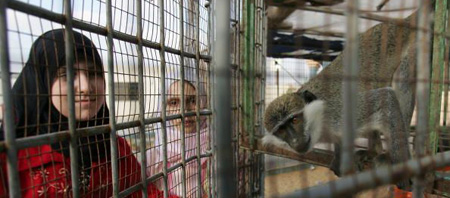Essential humanitarianism (the Gaza Zoo)
Leila points to a pretty intresting article by Darryl Li written after a recent visit to the Gaza strip. In his article ‘From Prison to Zoo: Israel’s “Humanitarian” Control of Gaza‘ (watch out, this is a link to a .doc file, what the fuck are they thinking at adalah.org?) he examines the policy of essentail humanitarianism develloped by the Israeli state after the take-over of the Gaza strip by Hamas last summer. Li claims that the conditions in Gaza have changed in such a way that it is more accurately described as a Zoo (as opposed as a prision) these days (and no he is not talking about the actual gaza zoo, where masked gunmen steal lions & parrots):
The metaphor of the Gaza Strip as the world’s largest prison is unfortunately outdated. Israel now treats the Strip more like a zoo. For running a prison is about constraining or repressing freedom; in a zoo, the question is rather how to keep those held inside alive, with an eye to how outsiders might see them. The question of freedom is never raised. The ongoing electricity crisis helps to illuminate this shift, so to speak. […]
The interaction between the state and the court is telling as regards the post-disengagement management of Gaza and the mentality of zoo-keeping. In 2006, Israel decided that the best way to punish Gazans for the capture of one of its soldiers was a one-off, spectacular act of violence that would lead to widespread deprivation. Now it seeks similar results - the loss of electricity and the resulting disruption of everyday life - through more calibrated, long-term means. This shift in approach is akin to the difference between clubbing an unruly prisoner over the head to subdue him and taming an animal through careful regulation of leash and diet. […]
The notion of “essential humanitarianism” (it is unclear what would constitute the “inessentially” humanitarian) reduces the needs, aspirations, and rights of 1.4 million human beings to an exercise in counting calories, megawatts, and other abstract, one-dimensional units that measure distance from death. It distracts from, and even legitimizes, the destruction of Gaza’s internal capacities and resources: its economy, institutions, and infrastructure. And even if implemented in good faith and with the best of intentions, it promises nothing more than turning Gazans one and all into beggars - or rather, into well-fed animals - dependent on international money and Israeli fiat.

